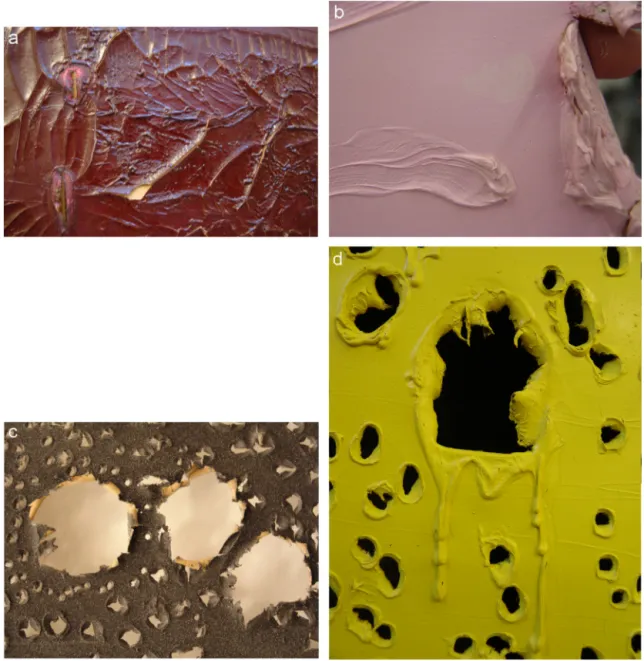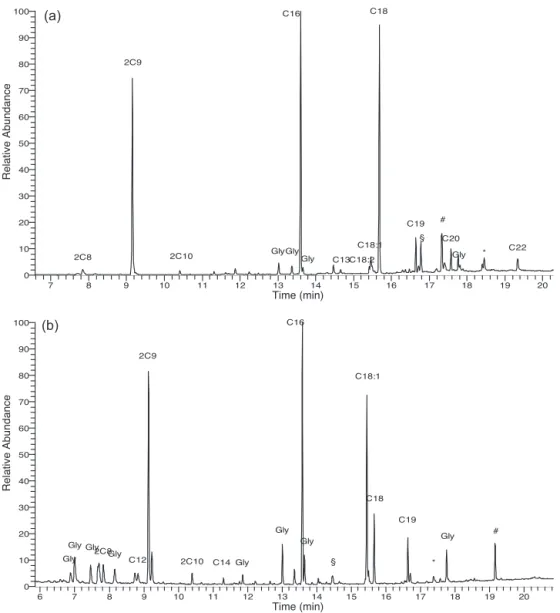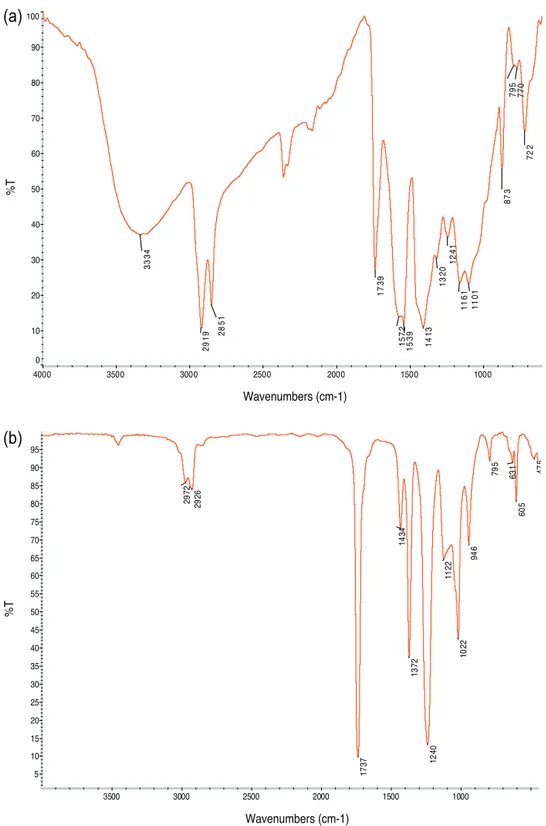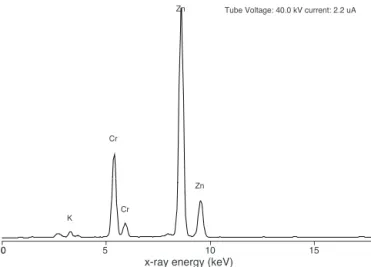Available
online
at
ScienceDirect
www.sciencedirect.com
Case
study
20th
century
artists’
oil
paints:
The
case
of
the
Olii
by
Lucio
Fontana
Francesca
Caterina
Izzo
a,∗,
Barbara
Ferriani
b,1,
Klaas
Jan
Van
den
Berg
c,2,
Henk
Van
Keulen
c,2,
Elisabetta
Zendri
a,3aCa’FoscariUniversityofVenice,DepartmentofEnvironmentalSciences,InformaticsandStatistics,ViaTorino155/b,30174VeneziaMestre,Italy bBarbaraFerrianisrl,ViaVettabbia1,20122Milano,Italy
cRCE-RijksdienstvoorCultureelErfgoed/NetherlandsCulturalHeritageAgency,SectorKennisRoerendErfgoed/ResearchMovableHeritage,P.O.Box76709, 1070KAAmsterdam,Netherlands
a
r
t
i
c
l
e
i
n
f
o
Articlehistory: Received13June2013 Accepted3November2013 Availableonlinexxx Keywords: LucioFontana FinediDio 20thcenturyoils Contemporarypaintings Manufacturedartists’oils GC-MStechnique Pictorialfilms Restorationa
b
s
t
r
a
c
t
Duringthe20thcentury,manyinnovativebindershavebeenrapidlyintroducedtotheartworldand soonbecamepopularasartists’paintsandpictorialmedia.However,despitetheadvantagesthatnew syntheticmaterialspresented,oilpaintshaveneverbeenentirelysubstituted.Indeed,thispaperfocuses ontheresultsprovidedbythescientificanalysisofagroupworksfromtheoeuvreofLucioFontana (1899–1968),allofwhichcreatedbetween1960and1964usingoil-basedmedia,andaimstoillustrate howoilscontainedinthepictorialmediahaveinfluencedtheseworks’respectiveageinganddegradation processes.DespitetheapparentcoherenceinthebehaviourofmanyofFontana’screations,someartworks revealeddiscrepanciesintermsofthephysicalandmechanicalbehaviourofthepictorialfilmsand inalterationsresultingfromdegradationprocesses.Samplestakenfromcasestudiesbelongingtothe OliiandFinediDioserieswereanalysedusingopticalmicroscopy,X-RayFluorescence(XRF), Fourier-TransformInfraredSpectroscopyinattenuatedtotalreflectance(FTIR-ATR)andGas Chromatography-MassSpectrometry(GC-MS)inordertostudyandidentifythematerialsemployedbytheartistandthe productsoftheirdegradationprocesses.Theseanalysesgaveunexpectedbutusefulresults(suchasthe presenceofnon-dryingorslow-dryingoilsinthepaintformulations)whichnotonlyprovideduswith newinsightintothenatureoftheconstituentmaterials,butalsofacilitatedtheelaborationofcorrect conservationmeasuresandsuitablerestorationinterventions.
©2013ElsevierMassonSAS.Allrightsreserved.
1. Introductionandaimsoftheresearch
During the first decadesof the 20thcentury, many innova-tivebinderswereintroducedtotheartworldandsoonbecame popularasartists’paintsandpaintingmedia[1–3].Asadirect con-sequence,thecompositionandnatureofmanyartisticandpictorial binderswerethussubjectedtoradicalchanges.However,despite theadvantagesthatthesenewsyntheticmaterialspresented,oils continuedtodominateasthemostversatilebindingmedium,and haveneverbeenentirelysubstituted[4,5].
Thisresearch, partof a larger researchproject dedicatedto thenature of 20thCentury artists’oilpaints (namely the 20th Century oilpaints Project), dealswith a groupof works by one
∗ Correspondingauthor.Tel.:+390412346730;fax:+390412346729. E-mailaddresses:[email protected](F.C.Izzo),[email protected]
(B.Ferriani),[email protected](K.J.V.d.Berg),
[email protected](H.VanKeulen),[email protected](E.Zendri). 1Tel.:+390258328511;fax:+390258327774.
2Tel.:+31203054710;fax:+31203054700. 3Tel.:+390412346730;fax:+390412346729.
of themostimportant Italian artistsofthe 20thcentury,Lucio Fontana(1899–1968).Eventhoughpreviousstudieshaveshown thatFontanahadstartedtousenewsyntheticbindersas substi-tutesfortraditionaloils[6–9],thissurveyfocusedspecificallyon theanalysisofworksfromtheOlliandtheFinediDioseries cre-atedbetween1960and1964,inwhich,theartistusedtheclassical pictorialmediumofoilswithnewexpressiveaims.Intheseseries, Fontanausuallyappliedmonochromaticpictoriallayerstothe can-vas,then,whilethemediumwasdrying,hepierced,engravedand manipulatedthepaint,whichsoakedintoandaroundtheedgesof theholesandevenleakedontotherearofthecanvas.Theartist appliedtheoilmediainathickimpastousingbrushes,spatulasand hisfingersinordertoachieveasculpturaleffect,andsometimes gluedshapedelementssuchassmallpiecesofcolouredglassor sequinsontothesurface.Thepaintlayersoftheworks belong-ingtotheseseriesarenormallycompactandrigid,and seldom presentconservativeproblems.However,withtimesomeofthe pictorialsurfaceshavebeguntoshowtheeffectsofthedrying pro-cessandthemovementofthesupport(whichgenerallymanifest intheformofcraquelures),but rarelyactuallossesinthepaint layeroritsdetachmentfromthecanvashavebeennoticed.Despite the apparentcoherencein the behaviourof many of Fontana’s 1296-2074/$–seefrontmatter©2013ElsevierMassonSAS.Allrightsreserved.
Pleasecitethisarticleinpressas:F.C.Izzo,etal.,20thcenturyartists’oilpaints:ThecaseoftheOliibyLucioFontana,JournalofCultural Heritage(2013),http://dx.doi.org/10.1016/j.culher.2013.11.003
ARTICLE IN PRESS
G Model
CULHER-2812; No.ofPages7
2 F.C.Izzoetal./JournalofCulturalHeritagexxx(2013)xxx–xxx
Table1
AshortdescriptionoftheanalysedpaintingsbyLucioFontanaandtheobservationsabouttheirstateofconservationbeforerestoration.
Paintingsa Description Stateofconservation
ConcettoSpaziale.Notted’amorea Venezia,1960,FondazioneLucio Fontana(60081),80×100cm
Thisrectangularcanvas,belongingtotheConcettoSpaziale(Olii)series, iscoveredinmonochromaticred-brownpaint;thepictorialsurface presentspunctures,cutsandscratchedincisions
Thereddish-brownpictoriallayerwas wrinkledandwidespreadcraquelure hascreated‘islands’whichtendto detachfromthefabricsupport(Fig.1a). Insomeplaces,thisphenomenonwas soadvancedthatithascausedlossesin thepaintlayer.Insomeparts,thepaint layerappearstobeextremelybrittle andfragile,whileinothers,itisstill stickyandonlypartiallydry ConcettoSpaziale,1962,Fondazione
LucioFontana(62O66), 145×115cm
Thisrectangularcanvas,belongingtotheConcettoSpaziale(Olii)series, iscoveredinmonochromaticpinkpaintwithslashes,cutsandgraffiti
ThesethreepinkConcettospaziale artworkspresentedallthesametypeof deterioration:strange,lighteryellow stainsintheformofdropsandpuddles werenotedonthepaintedsurfaces (Fig.1b)
ConcettoSpaziale,1962,Fondazione LucioFontana(1737/92), 100×80.5cm
Thisrectangularcanvas,belongingtotheConcettoSpazialeseries,is coveredinmonochromaticpinkpaintwithslashes,cutsandgraffiti ConcettoSpaziale.FinediDio,1963,
FondazioneLucioFontana(63FD 14),178×123cm
Thisovalpainting,belongingtotheConcettoSpaziale(FinediDio) series,ischaracterizedbyamonochromaticpinkpaintwithpunctures, cutsandscratchedincisions
ConcettoSpaziale.FinediDio,1963, FondazioneLucioFontana(63FD 23),178×123cm
Thismonochromaticblackovalwork,belongingtotheConcetto Spaziale(FinediDio)series,presentspunctures,slashesandsequins gluedtothesurface
InthisblackConcettoSpaziale,the edgesoftheslashesappearedtobe deformedandinsteadofprotruding ontotherear,theyappearedtohave contractedandhadpushedthrough ontothefrontofthecanvas(Fig.1c) Concettospaziale.FinediDio,1964,
FondazioneLucioFontana(64FD5), 178×123cm
Thismonochromaticyellowpaintingonanovalcanvaswith punctures,slashesandscratchesbelongstotheConcettoSpaziale(Fine diDio)series
Itdidnotpresentanyunusual alterationsandthereforerepresented anidealreferencestandard(Fig.1d) aFontana’sworksareclassifiedinthegeneralcataloguebyyear,theinitialletteroftheseriesandthenumberoftheworkwithinitsrespectiveseries–hence60O81 shouldbereadasaworkdatedto1960,belongingtotheOliiseriesandthe81stworkcataloguedinthisseries,andsoonfortheotherpaintingsanalysed.
creations, someworks belongingto theabovementioned series have revealed discrepancies in terms of both the physical-mechanical behaviour of the pictorial film and in terms of alterationsresultingfromdegradationprocesses.Ashort descrip-tion of the six works of art and the observations about their state of conservation before the restoration treatments are listed in Table 1. These anomalies could have been inter-preted as the results of ageing, humidity, heat, radiation or previous restoration processes, but with the aim of better understandingtheirconservationconditions and ageing behav-ior, it was decided to investigate the possibility that these anomalies resulted from the nature of the paint composition itself.
2. Experimental
2.1. Samples
Theopportunityofinvestigatingtheaforementionedartworks byFontanawaspresentedwhenthesepaintingsrequired restora-tion,andsampleswereprovidedthankstothegenerosityofthe works’ownersandtheFondazioneLucioFontanainMilan,Italy. Micro-fragmentsoftherespectivepictoriallayersweretakenfrom thebacksectionsorlateralmarginsofthepaintings,someofwhich alsocontainedthegroundlayerofthecanvas.Thesesampleswere foundtobecomposedofdifferentlayersofmonochromaticpaints andinsomecasescontainedglassfragmentsorsequins,gluedby theartistonthepaint.
2.2. Instrumentaldetails
Sampleswereobservedboth invisibleand UVlightwithan OlympusSZX16opticalmicroscopeequippedfor microphotogra-phy.
XRFwascarriedoutusingaBrukerTracerIII-VportableXRF instrument,equippedwithalowpowerRh-tubeoperatingat40kV and2.2uAandapeltiercooledSi-PINdetector.
FTIR-ATRwasperformedusingaPerkinElmerSpectrum1000 FTIRcombinedwithaGrasebySpecacGoldenGateSingleReflection DiamondATR,from4000to600cm−1for64scansandaresolution of4cm−1.
GC-MSanalysiswasperformedusingaThermoQuestGC-8000 instrumentwitha SupelcoColumnequity5,30m, 0.25mm,0.5 uminterfacedwithMSMD-800.Theinlettemperaturewas300◦C, theMS interface wasat 270◦C. The temperatureprogram was setfrom120◦C to300◦Cwitha ramp of10◦C/min,3min.The MS was run in Full Scan mode(m/z 40-600), 1.9 scans/s. Sol-vent delay wasset at 4.5min. The transfer line was at 240◦C andthesourcetemperaturewas220◦C.ElectronIonisationenergy was70eV.Sampleswerepreparedusing(trifluoromethylphenyl) trimethylammonium hydroxide, overnight reaction: fatty acids weretransesterifiedintotheircorrespondentmethylesters,while the glycerol reacted forming different (trifluoromethyl)phenyl ethers[10,11].
3. Resultsanddiscussion
Table2fullyreportsthetypologyoftheexaminedsamplesand theanalyticalresultsobtainedbyXRF,FTIR-ATRandGC-MSonthe sixFontana’spaintings.
TheConcettospaziale.Notted’amoreaVenezia(60O81)(detail showninFig.1a)wasanalysedasbothgroundandpictorial lay-ers.Thewhitegroundlayeriscomposedofamixtureoflinseed oilandleadwhite(2PbCO3·Pb(OH)2),withzincoxide(ZnO),
cal-ciumcarbonate(CaCO3)andbariumsulphate(BaSO4)aswhiteners
and/orfillers.Thepresenceof aleadsoap wasobserved thanks totheFTIRabsorptionpeakataround1530cm−1:thiswasmost likelyduetotheabsorptionofleadcarboxylatesformedas prod-uctsafter thereactionof the oilbinder withthelead pigment
this article in press as: F.C. Izzo, et al., 20th century artists’ oil paints: The case of the Olii by Lucio Fontana, Journal of Cultural (2013), http://dx.doi.org/10.1016/j.culher.2013.11.003
AR
TICLE IN PRESS
No. of Pages 7 F.C. Izzo et al. / Journal of Cultural Heritage xxx (2013) xxx–xxx ConcettoSpaziale. Notted’amorea Venezia (60O81)Whitegroundlayer S,Ba.Ca,Zn,Pb Dryingoil Carbonates Calciumsulphate Leadcarboxylates
Saturatedmonocarboxylic(lauric,myristic, palmitic,stearic)anddicarboxylic(suberic, azelaic,sebacic)acids;unsaturated(oleic) acids;glycerol
P/S=1.4 A/P=5.6
Thegroundlayeriscomposedofa mixtureoflinseedoilandleadwhite (2PbCO3*Pb(OH)2)withzincoxide
(ZnO),calciumcarbonate(CaCO3)and
bariumsulphate(BaSO4)as
whiteners/fillers.Itshowsthepresence ofleadsoaps
Thered-brownlayeriscomposedofa modifiedlinseedoilpaintwiththe additionofricinoleicacid,mixedwith alizarin
Red-brownpaint TracesofS,Ba.Ca, Zn
(probably contamination fromtheground layer) Oil-basedpaint Organicred dyestuff (1,2-dihydroxyanthraquinone, alsoknownas alizarin,Mordant Red11orTurkey Red) Alizarin
Saturatedmonocarboxylic(palmitic,stearic, arachidic,behenic)anddicarboxylic(suberic, azelaic,sebacic)acids;unsaturated(oleic, linoleic)acids;glycerol;ricinoleicacid P/S=1
A/P=3.2 ConcettoSpaziale
(62O66)
Pinkpaint Zn Oil-basedpaint
Zinccarboxylates Organicred dyestuff Calciumcarbonate
AntinoloRedBalsoknownasThioindigoRedB ((2Z)-2-(3-oxo-1-benzothiophen-2-ylidene)-1-benzothiophen-3-one)
Saturatedmonocarboxylic(lauric,myristic, palmitic,stearic)anddicarboxylic(suberic, azelaic,sebacic)acids;unsaturated(oleic) acids;glycerol;specialunsaturatedfattyacids (erucicandgondoicandtheiroxidation products13,14-dihydroxydocosanoicand 11,12-dihydroxyeicosanoiacids) P/S=3.5
A/P=1.6
Thepinkcolorationisgivenbyanorganicred dyestuff(AntinoloRedB)whitenedwithzinc oxide(ZnO).Calciumcarbonate(CaCO3)was
addedasfiller/extender.Zincsoapswere detected
Thepaintisanoil-basedpaintcontaining rapeseedoil
ConcettoSpaziale (1737/92)
Pinkpaint AsforConcetto Spaziale (62O66)
AsforConcetto Spaziale (62O66)
AsforConcettoSpaziale(62O66)but P/S=3.4
A/P=1.8 ConcettoSpaziale.
FinediDio (63FD14)
Pinkpaint AsforConcetto Spaziale (62O66)
AsforConcetto Spaziale (62O66)
AsforConcettoSpaziale(62O66)but P/S=3.4
A/P=1.7 ConcettoSpaziale.
FinediDio (63FD23)
Blackpaint Ca,P,Fe,Pb,Zn Dryingoil Prussianblue/black silicates
Saturatedmonocarboxylic(lauric,myristic, palmitic,stearic)anddicarboxylic(suberic, azelaic,sebacic)acids;unsaturated(oleic) acid;glycerol
P/S=1.3 A/P=3.1
Theblackcolorationisduetothe presenceofpigmentssuchasbone blackorivoryblack(Ca3(PO4)2)and
Prussianblue(Fe4(Fe(CN)3)3).The
presenceofquartzandsilicatesis linkedtotheuseofsequins,which wereappliedonthepaintedsurface usingapoly-vinyl-acetate-basedglue Thepaintmediumisadryingoil (linseedoil?) Adhesivefor sequins – Poly-vinyl-acetate (PVAc) – Concettospaziale. FinediDio (64FD5)
Yellowpaint K,Cr,Zn Dryingoil Zinccarboxylates Calciumcarbonate
Saturatedmonocarboxylic(lauric,myristic, palmitic,stearic)anddicarboxylic(suberic, azelaic,sebacic)acids;unsaturated(oleic) acids;glycerol;specialunsaturatedfattyacids (erucicandgondoicandtheiroxidation products13,14-dihydroxydocosanoicand 11,12-dihydroxyeicosanoiacids) P/S=1.7
A/P=1
Thepaintedlayersarecomposedofzincyellow (ZnCrO4+K2CrO4)andanoil-basedpaint
containingrapeseedoilprobablymixedwith linseedoil
Calciumcarbonate(CaCO3)wasaddedas
filler/extender.Zincsoapsweredetected
Pleasecitethisarticleinpressas:F.C.Izzo,etal.,20thcenturyartists’oilpaints:ThecaseoftheOliibyLucioFontana,JournalofCultural Heritage(2013),http://dx.doi.org/10.1016/j.culher.2013.11.003
ARTICLE IN PRESS
G Model
CULHER-2812; No.ofPages7
4 F.C.Izzoetal./JournalofCulturalHeritagexxx(2013)xxx–xxx
Fig.1.DetailsofLucioFontana’spaintingsshowingthedegradationphenomenaandthepeculiarityoftheartist’stechnique:a:Concettospaziale-Notted’amoreaVenezia(60 081);detailofthewidespreadcraquelureandpaintlosses;b:Concettospaziale(62O66);detailofthewhitishspotonthepaintedsurface;c:Concettospaziale-LaFinediDio (63FD23);detailofthedeformationoftheedgesoftheslashes;d:Concettospaziale-LaFinediDio(64FD5);detailofthecutsandslashesonthepaintedcanvas.
[12–14]. The coloration of the red-brown paint is attributable tothepresenceofalizarin,anorganicreddyestuffmainly com-posedof1,2-dihydroxyanthraquinone[15],whilethemediumwas identifiedasanoil.Inadditiontotheusualsaturatedand unsat-uratedfattyacids,thepresenceofricinoleicacid,formallycalled 12-hydroxy-9-cis-octadecenoic,wasdetectedbyGC-MSanalysis (Fig.2a).Thismonounsaturatedfattyacidisthemainconstituent (upto95%)ofcastoroil,whichisanon-dryingoilobtainedfrom castorseeds.Itislikelythattheredpaintinthispaintingcontained modifiedlinseedoil,thatislinseedoilwiththeadditionofcastor oil,assuggestedalsobythefactthatafter50years,thepainting doesnot appeartohavedried completely.Thepresenceof this oilbindermayexplainsomeofthesignsofdegradationevident inthepictoriallayers(bothhardfracturedandstickyareas),and thewrinklesthathaveformedonthesurfacemightbelinkedto thisuseofcastoroilinthethick,bodiedpictoriallayer.Overtime, theevaporationofvolatilecompounds(suchasalcohols,aldehydes andketones)fromtheoxidativecross-linkingreactionsoccurred, leadingtoweightlosses[16].Asthedryingspeedisslowedbythe
presenceofanon-dryingoil,itispossiblethattheevaporationrate alsooccurredslowly,causingtheformationofmorevisible,deeper wrinkles[17].
Then three ‘pink’ Concetto spaziale (a detail of the painting labelled62O66 isdepictedinFig.1b)werestudied,sincethey demonstratedsimilaritiesregardingthedegradationphenomena (see Table1)and theformulation ofthepaints, theresultsare hereinaftertreatedtogether.Thepinkcolourwasfoundtobethe resultofamixtureofanorganicreddyestuff(likelyAntinoloRedB alsoknownasThioindigoRed)withzincwhite(ZnO)aswhitener. Thebindingmediawereidentifiedas dryingoils; moreover,all theFTIR-ATRspectrareportedaclear,broadcarboxylate absorp-tionaround1570-1540cm−1(seethespectrumdepictedinFig.3a). Thesepeaksarepossiblytheresultoftheinfluenceofzincwhite inthedryingandageingoftheoilastheycouldrefertothe forma-tionofmetalcarboxylates(soaps)withthecarboxylicacidspresent [12,18].Metalsoapscanbeformedafterhydrolysisof thefatty acidmoleculesinthetriglyceridesofdryingoilswithmetal-based pigments;however,thepresenceofaddedstearatesasdispersion
, , 7 8 9 10 11 12 13 14 15 16 17 18 19 20 Time (min) 0 10 20 30 40 50 60 70 80 90 100 Relative Abundance Gly 2C10 Gly C22 § # Gly C20 C13C18:2 C18:1 C16 C18 2C9 2C8 C19 * Gly 6 7 8 9 10 11 12 13 14 15 16 17 18 19 20 Time (min) 0 10 20 30 40 50 60 70 80 90 100 Relative Abundance § * C19 Gly C14 C12 Gly Gly Gly Gly Gly Gly 2C9 2C8 2C10 C16 C18 C18:1 # Gly
(a)
(b)
Fig.2. TotalioncurrentchromatogramsofaredsamplefromConcettospaziale.Notted’amoreaVenezia(a)andapinkpaintsamplefromConcettospaziale–FinediDio(63FD 14)(b):a:TICofredsamplefromConcettospaziale.Notted’amoreaVenezia,aftertransesterificationandGC-MSanalysis(Gly=glycerol,2C8=subericacid,2C9=azelaicacid, 2C10=sebacicacid,C16=palmiticacid,C18:1=oleicacid,C18=stearicacid,C19=nonadecanoicacid,internalstandard,C20=arachidicacid,C22=behenicacid,#=ricinoleic acid,§=ricinoleicacid,methoxy,*=9,10-dihydroxyoctadecanoicacid);b:TICofpinkpaintfromConcettospaziale–FinediDio(63FD14),aftertransesterificationandGC-MS analysis(Gly=glycerol,2C8=subericacid,C12=lauricacid,2C9=azelaicacid,2C10=sebacicacid,C14=myristicacid,C16=palmiticacid,C18:1=oleicacid,C18=stearicacid, C19=nonadecanoicacid,internalstandard,*=gondoicacid,#=erucicacid).
agentsinthepaintformulation[19,20]cannotbeexcluded.Aminor additionofcalciumcarbonateasafillerorextenderissuggestedby carbonaticabsorptionpeaksat1413and873cm−1.Amongstthe characteristicdryingoilcompounds,twouncommonfattyacids weredetectedbyGC-MSanalysis(Fig.2b):erucic(13-docosenoic) and gondoic (11-eicosenoic) acidsand their oxidation products (13,14-dihydroxydocosanoicacidand11,12-dihydroxyeicosanoic acidrespectively).Theseunsaturatedfattyacidsareconsideredto bebio-markersastheyarepresentonlyinoilsobtainedfromthe seedsofBrassicaceae,suchasrapeseedoil[21].Moreover,theP/S ratiosforthepinkworksarearound3.6andmayrefertotheuse ofrapeseedoil(whoseP/Sisaround3.5–3.8)asbindingmedia. Thisisasemi-dryingoilwhichwasintroducedinthe20thcentury accordingtomodernartists’handbooks[4,5].Thehighcontentof oleicacidandtheconsequentiallyhighdegreeofunsaturationis mostlikelytobeaconsequenceofthepresenceofaslow-drying oil,butthisphenomenacouldalsobeexplainedinanotherway–in fact,thesignificantamounts ofoleicacidmaybelinkedtothe presenceofzincoxide,whichhavealsobeennotedinother art-works.It would thus appearthat in anoil-basedmedium, zinc oxideformsapackedstructurewhichisabletotrapoleicacidin
thepictoriallayer:thiseffectcanalsooccuryearsafterthe oxida-tionprocessends[22–24].Theunusualdegradationphenomena observedinallofthesepaintingsmightbetheresultofthe pres-enceofaslow-dryingoil(rapeseedoil)containingalargeamount ofunsaturatedacids(oleic,erucicandgondoicweredetectedafter almost50years)whosetriglyceridesreactedwithzincwhitefrom the painted layers to form metal soaps. As FTIR analyses sug-gest, metal soapsare present in the formof zinc carboxylates, and henceit is probablethat zinc soapsarepresent as formed and/oraddedsoaps(asdispersionagents)andthattheymigrated and conglomerated on the surface, forming the light yellow spots.
Althoughit didnot showany evidentdegradation phenom-enaonthesurface (Fig.1d),similar resultswerefoundfor the artworknamedConcettospaziale.FinediDio,(64FD5).The yel-lowcolorationisduetotheuseofzincyellow(ZnCrO4+K2CrO4)
(seeXRFreportedinFig.4), whilethemediumisanoil.GC-MS resultsarecomparablewiththepinkseries:besidesthepresence ofcommonfattyacids,theyellowpaintexhibitshighamountsof unsaturatedoleic,gondoicanderucicacids.Thepresenceof rape-seedoilis alsosuggestedin this case,although theP/Sratiois
Pleasecitethisarticleinpressas:F.C.Izzo,etal.,20thcenturyartists’oilpaints:ThecaseoftheOliibyLucioFontana,JournalofCultural Heritage(2013),http://dx.doi.org/10.1016/j.culher.2013.11.003
ARTICLE IN PRESS
G Model
CULHER-2812; No.ofPages7
6 F.C.Izzoetal./JournalofCulturalHeritagexxx(2013)xxx–xxx
72 2 77 0 79 5 8 73 50 60 70 80 90 100 %T 8 11 0 1 11 61 12 41 13 2 0 14 1 3 15 3 9 15 72 17 39 28 5 1 29 1 9 33 3 4 0 10 20 30 40 1000 1500 2000 2500 3000 3500 4000 Wavenumbers (cm-1) 47 5 60 5 63 1 79 5 94 6 11 2 2 14 3 4 29 26 29 72 50 55 60 65 70 75 80 85 90 95 %T 10 22 12 40 13 7 2 17 37 5 10 15 20 25 30 35 40 45 1000 1500 2000 2500 3000 3500 Wavenumbers (cm-1)
(a)
(b)
Fig.3.FTIR-ATRspectraofthepinkpaintinConcettospaziale-LaFinediDio,(63FD14)(a)andoftheadhesiveusedtogluesequinsinConcettospaziale-LaFinediDio,(63FD 23)(b):a:FTIR-ATRspectrumofthepinkpaintinConcettospaziale-LaFinediDio,(63FD14);b:FTIR-ATRspectrumoftheadhesiveusedtogluesequinsinConcettospaziale-La FinediDio,(63FD23).
1,7-this valuesuggeststhemixturewithotheroilmedia(such asthetraditional linseed oil). Asobserved inthe pinkOlii,the abundantoleicacidcontentmightberelatedtotheactionofzinc pigmentsandthebroadFTIRpeakat1574cm−1canbeexplained bythepresenceofzincsoaps,formedand/oraddedinthepaint formulation.
ThelastanalysedpaintingisablackConcettospaziale–Finedi Dio(63FD23)(Fig.1c),whosecolorationisduetothepresenceof pigmentssuchasboneblackorivoryblack(Ca3(PO4)2)andPrussian
blue(Fe4(Fe(CN6)3)).Fromsamplestakenfromthepictoriallayer
(includingareasinwhichthesequinswerepresent),itwas ascer-tainedthatitwasaoil-basedpaint.Thehighdegreeofunsaturation associatedwiththehighcontentof oleicacidsuggeststhatthe paint,even50yearsafteritsapplicationtothecanvas,isstill imma-tureorthatanon-dryingoilwasaddedtothepaint.TheP/Sratio is1.3,valuewhichisconventionallyreferredtolinseedoil[25]; nevertheless,theuseofthistraditionalbinderisrather improb-able,duetothedifferentbehaviorshown bythepictoriallayer underexamination.Itislikelythatotherlipidicbinders, exhibit-ingsimilarP/Sratio,wereemployed[4,5,11,21].Inthissample,the
Tube Voltage: 40.0 kV current: 2.2 uA
Cr
Zn
0 5 10 15
0
x-ray energy (keV)
K
Cr
Zn
Fig.4. XRFspectrumofayellowpaintsamplefromConcettospaziale-LaFinediDio (64FD5).
sequinsappearednotonlytobeembeddedinthepictorialfilm, butinsomeplaceswerealsoembeddedinasuperficiallayerof polyvinylacetate(PVA)-basedadhesive(mostlikelytobeVinavil®, producedbytheItaliancompanyMontecatini)(Fig.3b).Thisglue couldhaveplayedaroleinthecreationoftensionsandthe defor-mationofthepictoriallayers,howeverthereisalsothepossibility thatthisalterationcouldbecausedbytheextremethinnessofthe pictorialfilm.
4. Conclusions
Theresultsobtainedbythisstudyhaveprovideduswith impor-tantinformationregardingtheworksoftheOliiseriescreatedby LucioFontanabetween1960and1964.Duringthesameperiod,the artistexperimentedwithseveraldifferentandinnovativepictorial binders,butstilltendedtowardsmoretraditionalbinding materi-als.Fontanahimselfwasknowntobeanexperimentalartistand heusedtomixhousepaintswithmanufacturedoilpaints[7–9]. Nevertheless,aswehaveproven,Fontanausedoilpaints contain-ingdifferentlipidicbinders: anon-dryingoilsuchascastoroil, asemi-dryingoilsuchasrapeseedoilandthetraditionaldrying binder,linseedoil.ItisnotclearifFontanawishedtoexperiment withdifferentkindsofoilsinordertoachievedifferenteffectsor ifhesimplyusedreadymadepaintswithoutknowingtheir com-position,however,thematerialsandthetechniquesthatheused arenowproventobecloselylinkedtotheconservationproblems exhibitedbythepictoriallayersandobservedduringconservation treatments.Furthermore,theseanalysesgaveunexpected,but use-fulresultswhichnotonlyprovideduswithnewinsightintothe natureoftheconstituentmaterials,butalsofacilitatedthe identi-ficationofsuitableconservationmethods.
From an analytical point of view, this study has reinforced previouslystatedconclusionsthatmaintainthatmodernand con-temporaryartistsusedandstillusevaryingformsofthistraditional medium–which areoftengenerically labelledas‘oils’–without anyspecificregardtotheirbindingproperties.Theuninformeduse oftheseoilsdemandsthateachcasestudybeanalysedseparately inordertodevelopsuitabletreatmentmethodsforeachandevery workandavoiddetrimentalgeneralisations.
Acknowledgements
Thisresearchprojectwasmadepossiblethankstothe collabo-rationoftheFondazioneLucioFontanainMilanandistheresultofa
collaborationbetweentheCa’FoscariUniversityofVeniceandthe NetherlandsCulturalHeritageAgency/RCE(Rijksdienstvoor Cul-tureelErfgoed,formerlyICN-InstituutCollectieNederland)andis partofthewider20thCenturyoilpaintsProjectcarriedoutbyRCE incooperationwiththeCourtauldInstituteofArt(CIA),theGetty ConservationInstitute(GCI)andtheTate.SpecialthanksgotoDr. LucMegensandDr.SuzanDeGrootofRCEfortheirassistancein performingXRFandFTIR-ATRanalyses.
Thisstudywasfinanciallysupportedbythe2008–2010PRIN Project“Behaviourofpolymericpictorialfilmsandmethodsforthe conservation”.
References
[1]T.J.S.Learner,Analysisofmodernpaints,TheGettyConservationInstitute,Los Angeles,2004.
[2]M.Pugliese,Imaterialisinteticinell’artecontemporanea,Kermes30(1997) 21–30.
[3]O.Chiantore,A.Rava,Conservarel’artecontemporanea:problemi,metodi, materiali,ricerche,MondadoriElecta,Milano,2005.
[4]R.Mayer,Theartist’shandbookofmaterialsandtechniques.RevisitedEdition, Viking,NewYork,1991.
[5]M.Doerner,Thematerialsofartistsandtheiruseinpainting,Harvest,San Diego/NewYork/London,1984.
[6]B.Ferriani,R.Ploeger,T.Polietalii,LucioFontana.Betweentraditionand innovation,in:Art d’aujourd’hui.Patrimoine dedemain, Conservationet restaurationdesœuvrescontemporaines,Paris,2009.
[7]P.Gottschaller,LucioFontana:TheArtist’sMaterials,TheGettyConservation Institute,2012.
[8]P.Gottschaller,N.Khandekar,L.F.Lee,D.Kirby,TheevolutionofLucioFontana’s paintingmaterials,Stud.Conserv.57(2012)76–91.
[9]O. Chiantore, R. Ploeger, T. Poli, B. Ferriani, Materials and techniques in the pictorial oeuvre of Lucio Fontana, Stud. Conserv. 57 (2012) 92–105.
[10]K.R. Sutherland, Derivatisation using m-(trifluoromthyl)phenyltrimethyl-ammoniumhydroxideoforganicmaterialsinartworksforanalysisbygas chromatography-massspectrometry:unusualreactionproductswithalcohols, J.Chromatogr.A1149(2007)30–37.
[11]F.C.Izzo,20thcenturyartists’oilpaints:achemical-physicalsurvey(PhD the-sis),UniversityCa’Foscari,Venice,2011.
[12]j.vanderWeerd,A.vanLoon,J.J.Boon,FTIRstudiesoftheeffectsofpigments ontheageingofoil,Stud.Conserv.50(2005)3–22.
[13]R.Arbizzani,U.Casellato,E.Fiorin,L.Nodari,U.Russo,P.A.Vigato,Decay mark-ersforthepreventativeconservationandmaintenanceofpaintings,J.Cult. Herit.5(2)(2004)167–182.
[14]M.Favaro,S.Bianchin,P.A.Vigato,M.Vervat,ThepaletteoftheMacchiaItalian artistGiovanniFattoriinthesecondhalfoftheXIXthcentury,J.Cult.Herit.11 (3)(2010)265–278.
[15]E.Kampasakali,E.A.Varella,TheRussianavant-gardepaintingpalette: Docu-mentaryandphysicochemicalcodificationoforganiccolorants,J.Cult.Herit.9 (1)(2008)77–88.
[16]J.D.J.vandenBerg,K.J.vandenBerg,J.J.Boon,Chemicalchangesincuring andageingoilpaints,ICOMCommitteeforconservationpreprints1(1999) 248–253.
[17]D.Erhardt,S.C.Tumosa,M.F.Mecklenburg,Long-termchemicalandphysical processesinoilpaintfilms,Stud.Conserv.50(2005)143–150.
[18]L.Robinet,M.C.Corbeil,Thecharacterizationofmetalsoap,Stud.Conserv.48 (2003)23–40.
[19]C.S.Tumosa,Abriefhistoryofaluminumstearateasacomponentofpaint, WaacNewslett.23(2001)10–11.
[20]A.Burnstock,K.J.vanderBerg,S.deGrootetalii,Aninvestigationof water-sensitiveoilpaintsinthe20thcenturypaintings,in:T.J.S.Learner,P.Smithen, J.Kruegeretalii(Eds.),ModernPaintsUncovered,TheGettyConservation Insti-tute,LosAngeles,2007,pp.177–188.
[21]M.P.Colombini,F.Modugno,Organicmassspectrometryinartandarchaeology, Wiley&Sons,NewYork,2009.
[22]D.Rogala,S.Lake,C.Maines,M.Mecklenburg,Conditionproblemsrelatedto zincoxideunderlayers:examinationofselectedabstractexpressionist paint-ingsfrom thecollectionoftheHirshhornMuseumandsculpturegarden, SmithsonianInstitution,J.Am.Inst.Conserv.46(2010)96–113.
[23]G. Osmond,Zinc white: a review of zincoxide pigmentproperties and implications for stability in oil-based paintings, AICCM Bull. 32 (2011) 20–29.
[24]G.Osmond,J.J.Boon,L.Puskar,J.Drennan,Metalstearatedistributionsin mod-ernartists’oilpaints:surfaceandcross-sectionalinvestigationofreference paintfilmsusingconventionalandsynchrotroninfraredmicrospectroscopy, Appl.Spectrosc.66(2012)1136–1144.
[25]J.S.Mills,Thegaschromatographicexaminationofpaintmedia.PartI.Fatty acidcompositionandidentificationofdriedoilfilm,Stud.Conserv.11(1966) 92–108.



